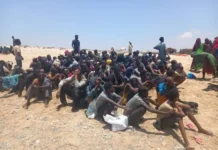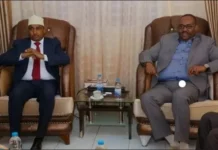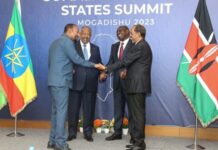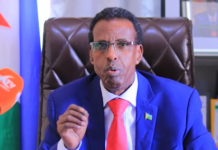An overview of the part of the eastern sector of the IFO-2 camp in the sprawling Dadaab refugee camp, north of the Kenyan capital Nairobi seen on April 28, 2015. AFP PHOTO/Tony KARUMBA Getty Images
The decision to close Kenya’s largest refugee camp – home to almost a quarter of a million people – is raising difficult questions, says Mollie Gerver.
Dadaab refugee camp, in eastern Kenya, was established almost 30 years ago. It currently hosts around half of the country’s refugees – 230,000 of almost 500,000, the majority Somalis who fled the civil war in their homeland in the 1990s, or came during the famine in 2011. Others have found themselves here having left South Sudan, the Democratic Republic of Congo and Burundi.
The Kenyan government recently ordered the UN Refugee Agency (UNHCR) to close the camp. It has not stated its reasons for this, but in the past has ordered similar closures on security grounds, claiming Dadaab could host terrorists from the Somali militant group Al-Shabaab.
On announcing the closure of the camp, the government said that the refugees would be relocated. For most, this means being moved to other camps, but for some this means repatriation: being sent back to their countries of origin. The government made a similar announcement in 2015 which led to over 80,000 refugees repatriating in three years. But violence and hunger led to 30,000 fleeing back to Kenya.
The 2015 repatriation plan was later declared unconstitutional by the Kenyan High Court on the grounds that the targeting of Somali refugees is an act of group persecution, illegal and discriminatory. But the government hopes to implement the new plan regardless.
Those being repatriated rely on the UNHCR which, using money from wealthy donor states, facilitates their transport. The UNHCR says that it only helps with voluntary returns. It also claims that repatriation is desirable when conditions in home countries have significantly improved, or returning is much safer than staying in the country of asylum.
But some human rights organisations have criticised the UNHCR for not giving refugees enough information and not living up to its commitments to ensure a truly voluntary return. Because the Kenyan government is ultimately responsible for whether Dadaab closes or not, the UNHCR’s options are limited to: Helping with repatriation regardless of whether refugees’ choices are voluntary; only repatriating those who seem to be returning voluntarily; or refusing to help with repatriation at all. But if the UNHCR were to pursue this last option, then all refugees would be denied access to repatriation.
None of these policies are ideal. The question is which is best. To determine what the UNHCR ought to do ethically, we need to consider whether refugees are truly voluntarily leaving, and what impact UNCHR repatriation has on government policy.
The UNHCR acknowledges that repatriation is often unsafe, but claims to be holding interviews with refugees considering return and repatriating only those whose choices seem voluntary. If choices are voluntary, perhaps the UNHCR’s repatriation assistance is ethical.
But if refugees are being forced out of Dadaab, their repatriation isn’t voluntary. Being forced out doesn’t necessarily mean being physically forced out of the country. It could mean that conditions are so challenging in the camp – and in Kenya in general – that choices to return are still involuntary.
For instance, refugees living in most camps in Kenya cannot legally leave or work and, because wealthy states do not provide enough aid, they don’t get enough food.
In 2018, I interviewed 22 South Sudanese refugees living in Dadaab camp, another in Kakuma, in the west of the country, and in Nairobi. I learned that they relied on food from relatives or friends. But even this wasn’t enough to ensure their health. They also faced persecution outside the camps. Police would often stop and detain them if they failed to pay bribes. Those choosing to repatriate to South Sudan felt they had little choice.
Similar testimonies are widespread among Somali refugees, who describe repatriation using the Somali proverb laba kala daran mid dooro – choosing the best of two bad situations.
Even if refugees are moved to other camps, they may suffer from even greater overcrowding and malnutrition. If refugees are choosing between malnutrition in a camp or war in home countries, it does not seem that their choices to return are voluntary.
The UNHCR might still justify providing repatriation on the grounds that it gives refugees more choices. But, because of restrictive government policies that often accompany repatriation announcements, evidence suggests it might actually restrict refugees’ choices, at least for those remaining in Kenya.
For example, in 2012 the Kenyan government announced that refugees would be required to live in camps – not cities or anywhere else. Two years later, the authorities further constrained the rights of refugees, carrying out arrests of those living in urban areas. It claimed the arrests were in response to a terrorist attack, but simultaneously instituted these policies alongside new repatriation programmes.
These policies force refugees to repatriate. This can be seen from those that choose to repatriate when policies change. In 2018, when the Kenyan high court declared the closure of refugee camps unconstitutional, only 7,543 repatriated.
This was a huge drop from when the government announced the closure of camps in 2016, when more than 33,000 refugees returned, and 2017 when 35,409 did so.
The Kenyan government may struggle to legally close Dadaab now, but even the possibility of closure may be enough to encourage more refugees to repatriate.
If the UNHCR refused to help with repatriation, the government may still close the camp. This would force refugees into other camps and they could still be denied the right to work in urban centres. Nonetheless, the UNHCR must consider the impact of its assistance on government policy. If the government’s goal in closing the camp is to encourage repatriation, and only the UNHCR can help with repatriation, then perhaps it should not help.
If it does not help with repatriation, the UNHCR can continue to use its budget to provide aid to refugees in Kenya. And if the government still closes the camp, despite the UNHCR refusing to help with repatriation, it still has the option of re-instituting repatriation in the future.
Mollie Gerver is an assistant professor in political theory at the University of Essex; this article also appears at theconversation.com







































